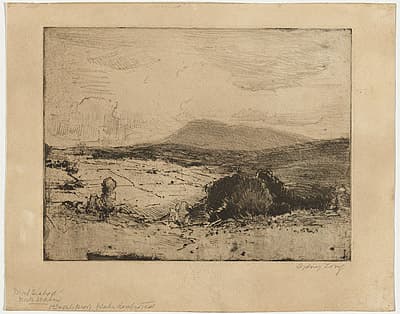Sydney
LONG
Australia
1871
–
London
1955
England, Europe 1910-21; Australia 1921- 22; England 1922-25; Australia 1925-52; England from 1952
15.8 (h) x 20.8 (w) cm
1st proof , Not published , no edition printed; only proof, plate destroyed , no manufacturer's mark
Signed lower right below plate-mark in black pencil, 'Sydney Long'. Titled lower left corner of sheet in black pencil, 'Moel Siabod / North Wales ['th Wa' underlined]'. Inscribed with edition details lower left corner of sheet in black pencil, '1st and only proof plate destroyed ['st' underlined]'.
Reference: Mendelssohn (1979), 94 National Gallery of Australia, Canberra NGA 1977.9.92 The Stephen Collection, purchased 1976. Reproduced with the kind permission of the Ophthalmic Research Institute of Australia
- J.W.F. Stephen, who formed a definitive collection of the etched work of Sydney Long. J.A.C. Stephen, the artist’s son, by descent. Purchased by the Australian National Gallery, from J.A.C. Stephen, Sydney, 1977.
Moel Siabod is a mountain in Snowdonia, North Wales, which sits above the villages of Betws-y-Coed and Capel Curig. The words moel siabod mean ‘shapely hill’. The two main ridges are rocky and the terrain around the lake tends to be boggy. In his etching, Long depicted the view from near Capel Curig. He represented this popular tourist site with sensitivity, conveying a sense of the grandeur of the mountain and the bleakness of the surrounding area.
Dorothy Ellsmore Paul states that Long produced one proof only of this print, which by 1928 was already in the possession of J.W.F. Stephen. Long had no proofs himself and had destroyed the plate. Indeed, Long wrote to Stephen, remarking: ‘you … have plates that are not on this list & I would like you to let me know what they are with a view of having them included in the book as rare prints. The ones I want I have marked with a *. I have no proofs whatever of these plates & should take great care of them if you will send them along to me’ (Stephen, 24 September 1928).
Long is likely to have made this print in Britain some time before his return to Australia in 1925, after which he preferred to make etchings of Australian subjects. The print is dated 1920 on this basis.
Moel Siabod is a mountain in Snowdonia, North Wales, which sits above the villages of Betws-y-Coed and Capel Curig. The words moel siabod mean ‘shapely hill’. The two main ridges are rocky and the terrain around the lake tends to be boggy. In his etching, Long depicted the view from near Capel Curig. He represented this popular tourist site with sensitivity, conveying a sense of the grandeur of the mountain and the bleakness of the surrounding area.
Dorothy Ellsmore Paul states that Long produced one proof only of this print, which by 1928 was already in the possession of J.W.F. Stephen. Long had no proofs himself and had destroyed the plate. Indeed, Long wrote to Stephen, remarking: ‘you … have plates that are not on this list & I would like you to let me know what they are with a view of having them included in the book as rare prints. The ones I want I have marked with a *. I have no proofs whatever of these plates & should take great care of them if you will send them along to me’ (Stephen, 24 September 1928).
Long is likely to have made this print in Britain some time before his return to Australia in 1925, after which he preferred to make etchings of Australian subjects. The print is dated 1920 on this basis.
Moel Siabod is a mountain in Snowdonia, North Wales, which sits above the villages of Betws-y-Coed and Capel Curig. The words moel siabod mean ‘shapely hill’. The two main ridges are rocky and the terrain around the lake tends to be boggy. In his etching, Long depicted the view from near Capel Curig. He represented this popular tourist site with sensitivity, conveying a sense of the grandeur of the mountain and the bleakness of the surrounding area.
Dorothy Ellsmore Paul states that Long produced one proof only of this print, which by 1928 was already in the possession of J.W.F. Stephen. Long had no proofs himself and had destroyed the plate. Indeed, Long wrote to Stephen, remarking: ‘you … have plates that are not on this list & I would like you to let me know what they are with a view of having them included in the book as rare prints. The ones I want I have marked with a *. I have no proofs whatever of these plates & should take great care of them if you will send them along to me’ (Stephen, 24 September 1928).
Long is likely to have made this print in Britain some time before his return to Australia in 1925, after which he preferred to make etchings of Australian subjects. The print is dated 1920 on this basis.

